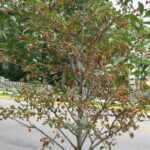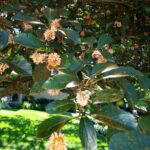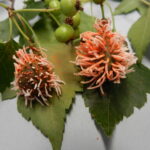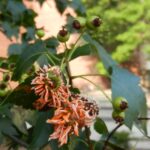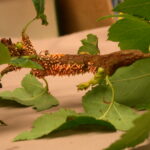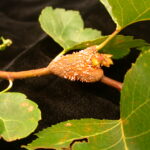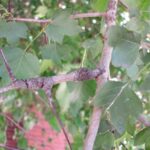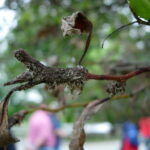Rust diseases produce some of the most dramatic symptoms and signs we see on woody plants in the landscape. These fungi live up to the name of ‘rust’ diseases because the spore structures they produce on the plant are generally bright orange, as shown by these examples: Cedar-apple rust (https://www.purduelandscapereport.org/article/orange-koosh-galls-on-eastern-red-cedar/), Hollyhock rust (https://www.purduelandscapereport.org/article/jolly-hollyhock-rust/) and Buckthorn rust (https://purdueplantdoctor.com/factsheet/tree-497).
The cedar-quince rust pathogen, Gymnosporangium clavipes, is no exception and causes disease on several ornamental plants in the rose family, including Serviceberry, Aronia, Quince, Pear, Apple and Crabapple. In Indiana we notice it most frequently on hawthorns. In years with wet springs we often see near 100% infection of hawthorn fruit (Figure 1, photo by Janna Beckerman, Figure 2), which develop distinctive bright orange spore-producing ‘horns’ (Figures 3 and 4). As with most other rust diseases the pathogen requires a second host plant to complete its life cycle, which can be Eastern redcedar or any of several types of juniper.
- Figure 1. photo by Janna Beckerman
- Figure 2
- Figure 3
- Figure 4
Diseased stems usually develop galls, which also produce spore horns (Figures 5 and 6). These typically die later in the year and may contribute to an overall decline in tree health (Figure 7). During the winter, when the orange rust fungus is not active, distorted stem and fruit may be mistaken for old insect galls (Figures 8).
- Figure 5
- Figure 6
- Figure 7
- Figure 8
Now is a good time to inspect the bare branches of your hawthorns to prune out and discard branch tissue with rust galls. Our extension bulletin, Cedar Apple and Related Rusts on Landscape Plants, has more information on managing this problem.
